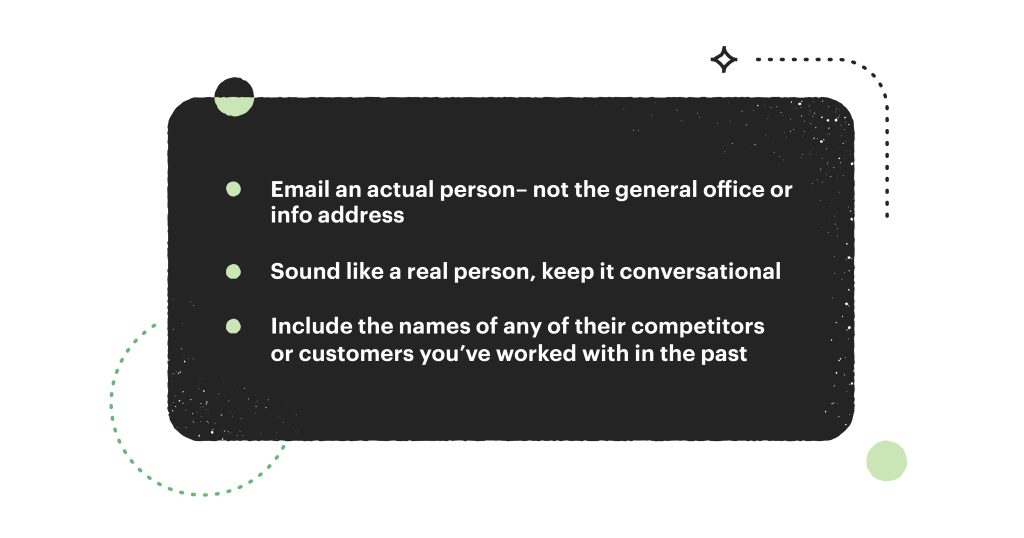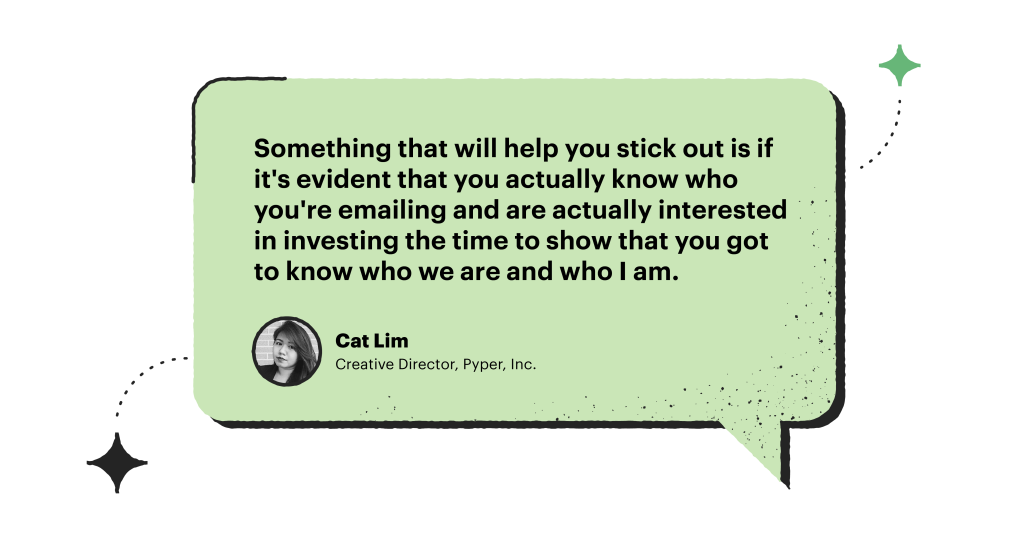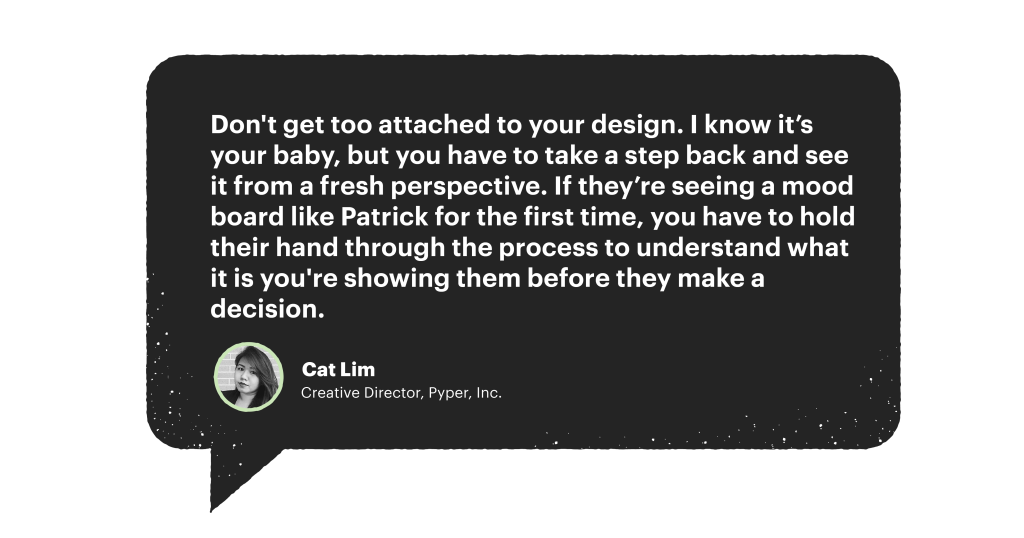How to sell it: creative agency tips
Cat Lim is the incredibly-talented creative director of Pyper, Inc. She sat down (virtually) with Travis Tyler and Patrick Downs on the Customer Engagement Lab podcast to share her favorite creative agency sales strategies – developing proposals, creating mood boards, presenting designs, and all.
And while Cat’s business is built almost entirely on inbound referrals, she gets tons of cold emails every week. She explains why she rarely opens them, what they get wrong, and the one cold email that got it right.
Grab a pen, there’s lots of goodness here!
Do cold emails right
On episode 18 of the podcast, Tyler presented a clip of a TikTok video found in a super-niche area for making the creative sale. Chock full of cold email tips, everyone agreed the video’s advice was solid. You can see it in the video version of the podcast, but this sums it up:

- Email an actual person– not the general office or info address (it shows you’ve done your research)
- Sound like a real person, keep it conversational (everyone loves human to human sales)
- Include the names of any of their competitors or customers you’ve worked with in the past (for a boost in credibility and a good start to build trust)
On the subject of making cold emails work, Cat receives tons of cold emails, but almost never responds. She says they’re almost always surface-level messages, and they read as if they could be copy-and-paste. You’ve probably gotten a few today. It’s as if someone grabs email addresses from LinkedIn, then sends out a mass, copycat campaign.
But one day, a cold email finally struck a chord. The sender, a printing company, called out her specific projects that left them impressed, and indicated how their services could actually support future projects like these. Cat was blown away that they took the time to get to know her company and their work and that they made it obvious in their email.
That awesome cold email even spawned a new email folder for vendors– and Cat might take them up on their offer in the future.
Stay away from these common tricks:
- Using “RE:” or anything else to make the recipient think an initial email is actually the continuation of an earlier conversation
- Making it seem as if you’re forwarding them an earlier conversation, when it’s actually the first email
Cat says tricks are deal breakers: “I’ll open [the email]. I’ll read the first couple of sentences. And then, I’m just annoyed.”

“Something that will help you stick out is if it’s evident that you actually know who you’re emailing and are actually interested in investing the time to show that you got to know who we are and who I am.” – Cat Lim, Creative Director, Pyper, Inc.
When you’ve scored a meeting
A lot of Cat’s business is inbound – usually referrals. So when someone gets in touch, she starts with an in-person meeting, lunch, or a phone call. She learns more about who they are and what they’re looking for. Then after the meeting, she thinks about what their actual needs might be versus what they think they need. Try not to feel daunted. In fact, Cat says figuring out clients’ problems is “like 90% of the fun”. Then she meets with them again to share the proposal and explain her suggestions.
There’s no need to copy her strategy. In fact, it usually goes this way, but she really has an unstructured approach. Instead, tweak it to your needs. Just make sure you’re using those intro calls wisely to get all of the necessary details:
- What is the project?
- What are their goals?
- How does the client value the project?
- Who are the decision makers?
- What is the desired timeline?
Then you’ll always be ready to offer great value when proposal time rolls around!
Pro Tip: Always try to get the decision makers on the proposal calls. It’ll boost your odds for making the sale.
Let your mood board communicate the vibe
The brand platform is a written statement – brand values, brand promise, unique selling proposition (USP), etc. And your mood board is its visual companion.
- Explain what a mood board is for clients who may not know. There are actually a lot of people who don’t fully understand what a mood board is, and since the concept can be so abstract, try not to assume. Cat says a mood board shows what a brand could look like in the future. It features color palettes, fonts, images, textures and general inspiration. And it’s put together almost like a Pinterest board. Feel free to explain it the same way. The mood board’s job is to make sure you’re on the same page before you start creating assets like a logo or videos.
- Present and pivot as needed. It’s about how it makes the client feel. Find out what the client thinks about the vibe and general direction. It’s an important milestone to make sure you’re on the same page. Do they want to be more approachable, should they be more sophisticated, etc.?
On doing rebrands from the ground up: “It’s always nice when you’re working with a brand where you get to work on [the project] holistically, and not just one piece, because everything works together really well.” – Cat Lim, Creative Director, Pyper, Inc.
How to pitch your designs to clients
Cat says it’s not just about paying attention to the designs you’re creating. Also think about how you’re going to present it to the client. She says, “It’s easy to get wrapped up in the details of your design, but you have to get out of your head.” Remember that the prospect has no idea what’s inside your head.
Learn how to communicate your vision in a way that makes it easy for anyone to understand. The client can’t opt in before understanding your concept.

“Don’t get too attached to your design. I know it’s your baby, but you have to take a step back and see it from a fresh perspective. If they’re seeing a mood board like Patrick for the first time, you have to hold their hand through the process to understand what it is you’re showing them before they make a decision.” – Cat Lim, Creative Director, Pyper, Inc.
From pitching to presenting and developing assets, Cat explains how important it is to get out of your head to think about the client’s needs.

- What are the client’s goals?
- Have you assessed their goals and their situation to truly determine their needs?
- Can you clearly explain your vision?
- Are you too attached to your ideas or designs?
- Are your pitches and proposals clearly communicated and do they really speak to their needs?
Hear the whole conversation – tune into the Customer Engagement Lab!